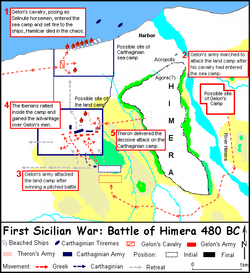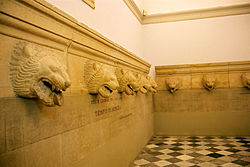Himera
The foundation of Himera is placed subsequent to that of Mylae (as, from their relative positions, might naturally have been expected) both by Strabo and Scymnus Chius: its date is not mentioned by Thucydides, but Diodorus tells us that it had existed 240 years at the time of its destruction by the Carthaginians, which would fix its first settlement in 648 BC.
[4] Not long after this event, Himera fell itself under the yoke of a despot named Terillus, who sought to fortify his power by contracting a close alliance with Anaxilas, at that time ruler both of Rhegium (modern Reggio di Calabria) and Zancle.
But Terillus was unable to resist the power of Theron, despot of Agrigentum (modern Agrigento), and, being expelled by him from Himera, had recourse to the assistance of the Carthaginians, a circumstance which became the immediate occasion of the first great expedition of that people to Sicily, 480 BC.
[5] The magnitude of the armament sent under Hamilcar, who is said to have landed in Sicily with an army of 300,000 men, sufficiently proves that the conquest of Himera was the pretext, rather than the object, of the war.
Despite the numerical inferiority of his forces, he defeated the army of the Carthaginians with such slaughter that the Battle of Himera in 480 BC was regarded by the Greeks of Sicily as worthy of comparison with the contemporary victory of Salamis.
[8] Shortly after, seeing that the city had suffered greatly from these severities and that its population was much diminished, he sought to restore its prosperity by establishing there a new body of citizens whom he collected from various quarters.
The greater part of these new colonists were of Dorian extraction, and though the two bodies of citizens were blended into one and continued to live harmoniously together, at this period Himera became a Doric city.
[11] In 466 BC we find the Himeraeans, in their turn, sending a force to assist the Syracusans in throwing off the yoke of Thrasybulus; and, in the general settlement of affairs which followed soon after, the exiles were allowed to return to Himera, where they appear to have settled quietly together with the new citizens.
[12] From this period Diodorus expressly tells us that Himera was fortunate enough to escape from civil dissensions,[13] and this good government must have secured to it no small share of the prosperity which was enjoyed by the Sicilian cities in general during the succeeding half-century.
That city was ill-prepared for defence; its fortifications were of little strength, but the citizens made a desperate resistance, and by a vigorous sally inflicted severe loss on the Carthaginians.
[16] And it seems clear that many of them at least availed themselves of this permission, as we find the Himeraeans subsequently mentioned among the states that declared in favour of Dionysius I of Syracuse, at the commencement of his great war with Carthage in 397 BC; though they quickly returned to the Carthaginian alliance in the following year.
[17] The explanation of this difficulty is furnished by Cicero, who tells us that, after the destruction of Himera, those citizens who had survived the calamity of the war established themselves at Thermae, within the confines of the same territory, and not far from their old town.
[21] It is much more strange that we find the name of Himera reappear both in Mela and Pliny, though we know from the distinct statements of Cicero and Strabo, as well as Diodorus, that it had ceased to exist centuries before.
[34] This distance was not too great to be reconciled with Cicero's expression that the new settlement (Thermae) was established non longe ab oppido antique;[32] while the addition that it was in the same territory [35] would seem to imply that it was not very near the old site.
Of the lower city the main visible remains consist of the monumental Tempio della Vittoria (Temple of Victory), a Doric structure built to commemorate the defeat of the Carthaginians.



